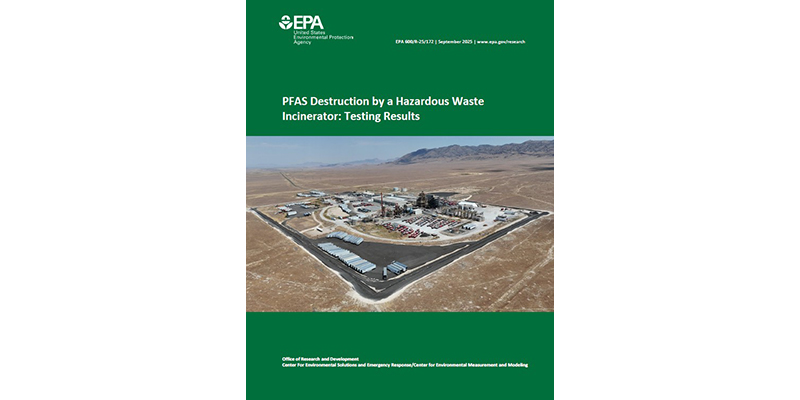October 17, 2025 — EA Engineering, Science, and Technology, Inc., PBC (EA), a leading provider of interdisciplinary environmental services, was a key contributor to the recent study that led to publication of the U.S. Environmental Protection Agency’s (EPA’s) comprehensive report, PFAS Destruction by a Hazardous Waste Incinerator: Testing Results. This study represents the most extensive evaluation to date of per- and polyfluoroalkyl substances (PFAS) destruction in a full-scale hazardous waste incinerator, conducted at the Clean Harbors Environmental Services hazardous waste incinerator facility in Aragonite, Utah.
The research, conducted in collaboration with the EPA Office of Research and Development, the Department of Defense Strategic Environmental Research and Development Program, and a multidisciplinary team, demonstrates that hazardous waste incineration can achieve destruction and removal efficiencies for PFAS as high as 99.9999 percent. The study’s findings provide critical data for regulators, industry, and communities seeking effective solutions for PFAS management.
EA played a leading role in the planning, execution, and interpretation of the study. The team’s efforts encompassed research and analyses, coordination of field sampling and laboratory analysis, and rigorous data validation. In addition to supporting test execution, EA’s technical team conducted detailed data evaluation and calculations to ensure that results fully reflected the study’s findings. Under the leadership of Vice President Jason McNew and Project Manager Erica Thieleman, EA played a pivotal role in designing and executing the test plan, applying stringent quality assurance protocols and maintaining the highest standards of scientific integrity. The study featured comprehensive mass balance calculations, process monitoring, and emissions sampling to ensure data quality and transparency. EA’s John Kumm, PE; Pavan Challa, PhD; Steve Yankay; Mahsa Modiri, PhD, PE; and Sanita Corum are among the report’s co-authors.
“This study marks a significant milestone in our understanding of PFAS destruction technologies,” said McNew. “The results show that, under the right conditions, hazardous waste incinerators can effectively destroy a wide range of PFAS, including those of greatest concern for human health and the environment. We are proud to support EPA’s mission and to contribute to the science that will inform future PFAS management and policy decisions.”
The EPA report details the methods, results, and lessons learned from a multi-year, multi-phase testing program. Key findings include:
- Hazardous Waste Incinerators can effectively destroy a wide range of PFAS under tested conditions, with measured stack gas concentrations generally below 25.0 nanograms per cubic meter, and process residues below 101 nanograms per gram.
- Destruction and Removal Efficiency for the 9 spiked PFAS ranged from 99.95% to 99.9999%, with similar results for indicator compounds such as hexafluoroethane.
- Trace levels of carbon tetrafluoride, detected near analytical limits, suggest possible formation of products of incomplete destruction under the high PFAS spike loads.
- Mass balance analysis and anomalous hexafluoropropylene oxide dimer acid detections in the stack samples and ash highlight the need for further research on the fate of a broader range of PFAS in similar systems, as well as comprehensive feed characterization to enable accurate mass balance closure.
- Ambient air dispersion modeling showed that predicted ambient concentrations of PFAS were several orders of magnitude below applicable state regulatory standards.
EA continues to advance PFAS research, including ongoing projects focused on developing and evaluating treatment options for PFAS in drinking water. These efforts are critical as communities nationwide seek reliable, science-based solutions to address PFAS contamination and protect public health.













